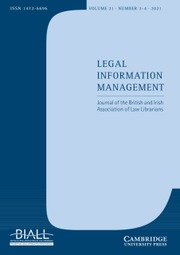No CrossRef data available.
Article contents
Open Justice and Access to Court Records in The Archives
Published online by Cambridge University Press: 10 June 2025
Abstract
This article by Dr Charlotte Smith, of The National Archives, begins by articulating the importance and character of open justice. It then examines how this is evidenced in the justice system, before exploring the factors shaping its implementation within the archives. It does this through a treatment of third-party access to court records. It concludes by identifying questions that the justice system and archives might consider when developing the archival policy and practice applicable to archived court records.
Information
- Type
- Main Features
- Information
- Copyright
- © The Author(s), 2025. Published by British and Irish Association of Law Librarians
References
Endnotes
1 Lord Atkinson in Scott v Scott [1913] UKHL 2; [1913] AC 417 at 463.
2 See ‘Transparency and Open Justice Board - Key Objectives Engagement explanatory notes’ www.judiciary.uk/wp-content/uploads/2024/12/Transparency-and-Open-Justice-Board-Key-Objectives-Engagement-explanatory-notes-1.pdf?utm_source=substack&utm_medium=email at paragraph 13: also Emma Cunliffe, ‘Open Justice Concepts and Judicial Approaches’ (2012) 40 Federal Law Review 385 and Edward Lui, ‘Demanding Transparency: Open Justice and English Administrative Law’ (2022) 138 Law Quarterly Review 481.
3 Toulson LJ in R (Guardian News and Media Ltd) v City of Westminster Magistrates’ Court (Article 19 intervening) [2012] EWCA Civ 420 at paragraph 4; Baroness Hale in Cape Intermediate Holdings v Dring [2019] UKSC 38 at paragraph 46.
4 See Joseph Jaconelli, Open Justice: A Critique of the Public Trial (OUP 2002); Linda Mulcahy, Legal Architecture: Justice, Due Process and the Place of Law (Routledge 2011); Open Justice: Court Reporting in the Digital Age (HC 339); Open justice: court reporting in the digital age: Government Response to the Committee’s Fifth Report of Session 2022–23 (HC 1040).
5 Which was recently considered in Dring and also Hayden v Associated Newspapers and HMCTS [2022] EWHC 2693 (KB).
6 See Paul Magrath ‘Judgments as Public Information’ (2015) 15(3) Legal Information Management 189; Nicklin J in Hayden at paragraphs 29 and 43.
7 See ‘Transparency and Open Justice Board - Key Objectives Engagement explanatory notes’ <www.judiciary.uk/wp-content/uploads/2024/12/Transparency-and-Open-Justice-Board-Key-Objectives-Engagement-explanatory-notes-1.pdf?utm_source=substack&utm_medium=email> at paragraph 12(d).
8 See, for example, PRO 56/67, PRO 56/215 and PRO 56/428 at TNA.
9 See Alison McClean, ‘Access under review”: Freedom of Information, Data Protection, and the Disappearing Archive’ <https://historyandpolicy.org/opinion-articles/articles/access-under-review-freedom-of-information-data-protection-and-the-disappearing-archive/>; Alison McClean, ‘“Prejudicial to the effective conduct of public affairs”: More questions for TNA on FOI and Reclosure’ <https://historyandpolicy.org/opinion-articles/articles/prejudicial-to-the-effective-conduct-of-public-affairs-more-questions-for-tna-on-foi-and-reclosure/> Accessed 18/01/2025.
10 Lady Hale in Dring at paragraphs 20 – 24; Nicklin J in Hayden at paragraph 68.
11 Mirroring the approach adopted by the Freedom of Information Act 2000 section 32.
12 See David S Ardia and Anne Kleinfelter, ‘Privacy and Court Records: An Empirical Study’ (2015) 30(3) Berkeley Technology Law Journal 1807.
13 For a reiteration of this foundational status see Sir Geoffrey Vos MR in Louise Tickle and Another v The BBC and Others [2025] EWCA Civ 42 at paragraphs 43 – 50 and 55.
14 See Dring at paragraph 34.
15 See Dring at paragraphs 41 and 43.
16 See also ‘Transparency and Open Justice Board - Key Objectives Engagement explanatory notes’ <https://www.judiciary.uk/wp-content/uploads/2024/12/Transparency-and-Open-Justice-Board-Key-Objectives-Engagement-explanatory-notes-1.pdf?utm_source=substack&utm_medium=email> at paragraph 13.
17 Which was the subject of a recent consultation – see <https://assets.publishing.service.gov.uk/media/65d70d232ab2b3e0f2759593/court-documents-consultation-cover-note.pdf> and <https://assets.publishing.service.gov.uk/media/65ce03a51305490011867aaa/court-documents-consultation.pdf> Accessed 17/01/2025
18 See Criminal Procedure Rules, Rule 5.10(9)(a); also Toulson LJ in R (Guardian News and Media Ltd) at paragraph 85 and Baroness Hale in Dring at paragraph 35.
19 See Archives Unlocked (2017) at <https://cdn.nationalarchives.gov.uk/documents/archives/Archives-Unlocked-Brochure.pdf>; also ‘Archives for Everyone, 2023 – 2027’ <https://www.nationalarchives.gov.uk/about/our-role/plans-policies-performance-and-projects/our-plans/archives-for-everyone/our-principles/> and Strategic vision for archives - Archives sector <https://www.nationalarchives.gov.uk/archives-sector/our-archives-sector-role/strategic-vision-for-archives/> Accessed 18/01/2025
20 The Report on Legal Records (Cmnd 3084 of 1966).
21 See ‘Record retention and disposition schedules’, GOV.UK <https://www.gov.uk/government/publications/record-retention-and-disposition-schedules>and ‘Operational selection policies by subject’, The National Archives <https://www.nationalarchives.gov.uk/information-management/manage-information/selection-and-transfer/selecting-records/osp-subject/>Accessed 15/01/2025
22 Visitor Survey 2022 HeadlineReport Final <https://static1.squarespace.com/static/60773266d31a1f2f300e02ef/t/649562e6281d3d55b8a7e586/1687511787134/Visitor+Survey+2022+HeadlineReportvFinal.pdf>
23 Figures compiled by, and used with the permission of, Cliff Van Dort (Head of Collections (Library) at The National Archives).
24 See Katherine Biber ‘In Crime’s Archive: The Cultural Afterlife of Criminal Evidence’ (2013) 53(6) The British Journal of Criminology 1033.
25 TNA holds the (selected) records of the central courts. Those of the local courts are dispersed across multiple local record offices.
26 For an overview and guide to the public records system see ‘How to manage your information’, The National Archives <https://www.nationalarchives.gov.uk/information-management/manage-information/><accessed 18/01/2025>.
27 See series descriptions for ASSI 2, 3, 11, 21, 31, 32, 41, 61 and 79 in TNA’s online catalogue.
28 See the series description for CRIM 6 at TNA.
29 See e.g. JR Ede to Thesiger, ‘Access to Legal Records’ (26 February 1968) in PRO 56/428 (TNA).
30 See Carlson, Jessamy. (2023) Defining ‘Proper Research’: Privileged Access, Local Authority Archives and the Academic Researcher. Archives and Records: < https://doi.org/10.1080/23257962.2023.2225038>.
31 See the administrative histories included the series level descriptions in TNA’s online catalogue.
32 As indeed has been the case in respect of many crown court and related files. On records access and reclosure at TNA see ‘Reclosure Panel’, The National Archives <https://www.nationalarchives.gov.uk/about/our-role/transparency/reclosure-panel/>and ‘Freedom of information requests’, The National Archives <https://www.nationalarchives.gov.uk/about/our-role/transparency/freedom-of-information-requests/> Accessed 18/01/2025
33 For definitions see ‘What is research-related processing?’, ICO <https://ico.org.uk/for-organisations/uk-gdpr-guidance-and-resources/the-research-provisions/what-is-research-related-processing/#criteria> Accessed 18/01/2025
34 See ‘Section 40 and Regulation 13 – personal information’, ICO <https://ico.org.uk/for-organisations/foi/section-40-and-regulation-13-personal-information/> <Accessed 18/01/2025
35 See ‘Guide to archiving personal data’, TNA <https://cdn.nationalarchives.gov.uk/documents/information-management/guide-to-archiving-personal-data.pdf> at paragraph 79.
36 See ‘What are the appropriate safeguards?’, ICO <https://ico.org.uk/for-organisations/uk-gdpr-guidance-and-resources/the-research-provisions/what-are-the-appropriate-safeguards/> and ‘Exemptions’, ICO <https://ico.org.uk/for-organisations/uk-gdpr-guidance-and-resources/the-research-provisions/exemptions/> Accessed 18/01/2025
37 On this see Michael Moss and David Thoma ‘Overlapping Temporalities - The Judge, the Historian and the Citizen’ (2017) 52(134) Archives 51.
38 Could work around the “Open Documents” principle provide a forum for this? See ‘Transparency and Open Justice Board - Key Objectives Engagement explanatory notes’ <www.judiciary.uk/wp-content/uploads/2024/12/Transparency-and-Open-Justice-Board-Key-Objectives-Engagement-explanatory-notes-1.pdf?utm_source=substack&utm_medium=email> at paragraph 12(d).

